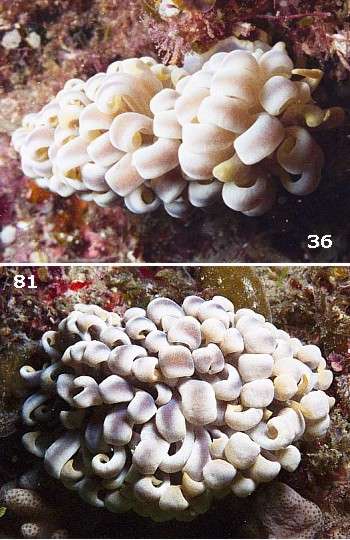
Phyllodesmium magnum
Rudman, 1991
Order: NUDIBRANCHIA
Suborder: AEOLIDINA
Family: Glaucidae
DISTRIBUTION
Known from tropical Western Pacific, and Western Australia. Records on the Forum show a widespread Indo-West Pacific distribution.
PHOTO
UPPER RIGHT: Kushimoto, Japan. PHOTO 36: 130mm long, July 1999. PHOTO 81: 100mm long, November 1999. PHOTOS: Yasuhiro Shirai.
LOWER PHOTOS: Noumea, New Caledonia, October 1988, 110mm long alive, Holotype. LEFT: Dorsal surface (left) of ceras and ventral surface (right), showing how the patches of zooxanthellae are concentrated on the upper (sunlit) side of each ceras. LOWER RIGHT: Showing disturbed animal which has cast off (autotomised) most of its cerata, showing the ridges on which the cerata are normally attached, and the position of the anal papilla (arrow). PHOTOS: Bill Rudman.
This is one of the larger species of Phyllodesmium, and from the branched arrangement of the digestive gland, flattened cerata, and position of zooxanthellae in the sunlit parts of the skin, it is most probably one of the species which retains zooxanthellae alive in its tissue so that it can benefit from their photosynthetic activity. See page on Solar-powered Sea Slugs for further detail.
All species of Phyllodesmium, feed on octocorals, and the defensive cnidosac found in other aeolids is absent. However, they have evolved an alternative defensive strategy. When attacked or disturbed their cerata can be cast off voluntarily, much like a lizard drops its tail. The autotomised cerata produce a sticky epithelial secretion and wriggle around vigorously for a considerable length of time after dropping off, apparently causing sufficient distraction to deter further interest in the now even more naked nudibranch.
This species probably feeds on, and obtains its zooxanthellae, from the soft coral Sinularia.
References:
• Rudman, W.B. (1981) The anatomy and biology of alcyonarian feeding aeolid opisthobranch molluscs and their development of symbiosis with zooxanthellae. Zoological Journal of the Linnean Society 72: 219-262.
• Rudman, W.B. (1991) Further studies on the taxonomy and biology of the octocoral-feeding genus Phyllodesmium Ehrenberg, 1831 (Nudibranchia: Aeolidoidea). Journal of Molluscan Studies, 57(2): 167-203.
LOWER PHOTOS: Noumea, New Caledonia, October 1988, 110mm long alive, Holotype. LEFT: Dorsal surface (left) of ceras and ventral surface (right) showing how the patches of zooxanthellae are concentrated on the upper (sunlit) side of each ceras. LOWER RIGHT: Showing disturbed animal which has cast off (autotomised) most of its cerata, showing the ridges on which the cerata are normally attached, and the position of the anal papilla (arrow). PHOTOS: Bill Rudman.
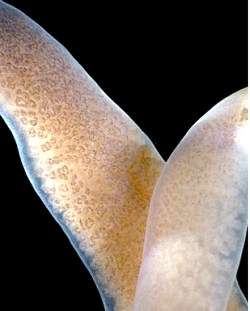
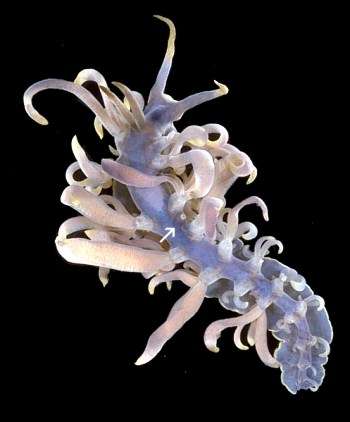
Rudman, W.B., 1999 (November 22) Phyllodesmium magnum Rudman, 1991. [In] Sea Slug Forum. Australian Museum, Sydney. Available from http://www.seaslugforum.net/find/phylmagn
Related messages
Phyllodesmium from Lembeh, Indonesia
March 2, 2009
From: Brian Mayes

Dear Bill,
Please can you identify this Phyllodesmium?
Locality: Bitung, Lembeh Straits, 18 Metres, Sulawesi, Indonesia, Molucca Sea, 18 January 2009, Sandy. Length: 30 mm. Photographer: Brian Mayes.
Kind Regards
Brian Mayes
brian.r.mayes@gmail.com
Mayes, B.R., 2009 (Mar 2) Phyllodesmium from Lembeh, Indonesia. [Message in] Sea Slug Forum. Australian Museum, Sydney. Available from http://www.seaslugforum.net/find/22295
Dear Brian,
Some of these species of Phyllodesmium can be a bit problematical but the general shape and colour, including the yellow border to the foot, and the arrangement of the digestive gland in the flattened cerata make me pretty sure this is Phyllodesmium magnum.
Best wishes,
Bill Rudman
Phyllodesmium magnum from Nhatrang, Vietnam
June 5, 2008
From: Hua Thai Tuyen

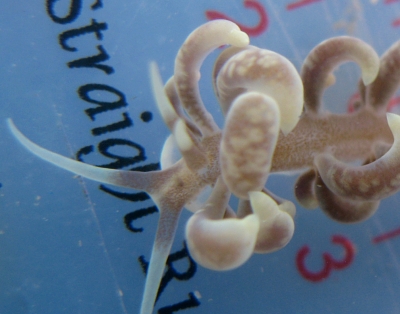
Concerning message #21423:
This is a picture from Nhatrang, Vietnam and I have not been able to ID it. Can you help?
Locality: Mieu Island (Nhatrang city), 5 m, Vietnam, South China Sea, 10 May 2008, Coral reef. Length: 13 mm. Photographer: Hua Thai Tuyen.
Hua Thai Tuyen
hthaituyen@yahoo.com
Hua Thai Tuyen, 2008 (Jun 5) Phyllodesmium magnum from Nhatrang, Vietnam. [Message in] Sea Slug Forum. Australian Museum, Sydney. Available from http://www.seaslugforum.net/find/21582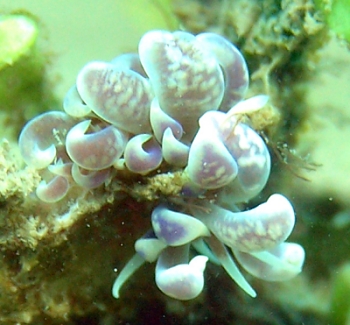
Dear Tuyen,
This is a species of Phyllodesmium, and I am pretty sure it is a juvenile Phyllodesmium magnum. The white patches on the cerata and the yellow tips are often present in this species.
Best wishes,
Bill Rudman
Re: Phyllodesmium magnum on Sinularia
April 4, 2008
From: Gary Cobb
Concerning message #21491:
Thank you Bill.
Yes it hard sometimes hard and frustrating for us to try an come up with all the answers. David Mullins and I have become so addicted to these animals. We really try to get "out there" and see what nature has for us to discover every opportunity we get. It is with great pleasure we can share our discoveries with the likes of you, Richard Willan, the boys in California and others we know in Australia.
We appreciate the work you do and the work all the Nudibranch experts in the World do, but it really eats us because we want ALL YOUR KNOWLEDGE!
We will never give up and always think of searching for Nudibranchs as the great Easter Egg Hunt of all time!
Cheers
Gary
gary@nudibranch.com.au
Cobb, G.C., 2008 (Apr 4) Re: Phyllodesmium magnum on Sinularia. [Message in] Sea Slug Forum. Australian Museum, Sydney. Available from http://www.seaslugforum.net/find/21494Dear Gary,
May every day be Easter day for you and David
Best wishes,
Bill Rudman
Re: Phyllodesmium magnum on Sinularia
April 4, 2008
From: Gary Cobb
Concerning messages #20977; #20978:
Thanks Bill for your comments.
As you know we are but 'Gentleman scientists' trying to bring information to the World as best we can. In regards to the juvenile animals, we thought the shapes of the cerata were the same as the adults as well as the positions on the body. The anterior ends all look the same as as the adults too.
One other question comes to mind too. In the two photos where the animals are eating, are the corals the same species?? They look different!
Thanks
Gary Cobb
gary@nudibranch.com.au
Cobb, G.C., 2008 (Apr 4) Re: Phyllodesmium magnum on Sinularia. [Message in] Sea Slug Forum. Australian Museum, Sydney. Available from http://www.seaslugforum.net/find/21491Dear Gary,
Our knowledge of the world would be much poorer without the efforts of what you call 'gentleman scientists'. Charles Darwin was an honoured amateur or gentleman scientist. One of reasons I spend so much of my time on the Forum is because I recognise the great wealth of untapped information and knowledge that is held by 'gentleman and lady scientists', enthusiastic amateurs, etc etc. When I asked why you thought the juveniles were juveniles, and why you thought they were P. magnum, it was to see if you had some background information to share with us all. Trained scientists often get criticised because they won't give a straight answer - they always want to add 'perhaps' or 'but' or 'if'. I guess we develop a way of thinking which puts value in retaining a doubt. Doubts are valuable because they leave the way open for new ideas, and for us to look just 'once more'. So my first thought when you said these were juvenile P. magnum, was 'how does Gary know that?' not because I disbelieved you or disagreed with you, but because it's important to know why you thought that - perhaps you found them on the same soft coral?, perhaps they had anatomical similarities ? etc. That is the way we build up knowledge, piece by tiny piece.
Concerning the soft corals. I don't claim any expertise in soft coral identification and like many marine invertebrate groups there is still much work to do. There is an excellent book on the topic (Fabricius & Alderslade, 2001) but as you will see there, some of the most common groups are not that easy, and photos alone are not always enough.
With that in mind, the one in your upper photo could well be Sinularia - which is the genus P. magnum has been reported on previously. There is a slight possibility it is Lobophyton, but as that genus has two types of polyps it's not possible to be sure from photos in which the polyps are retracted. And of course the skeletal sclerites and other internal features can't be seen. The soft coral in your lower photo lacks any lobes and could well be Sarcophyton. In your photo you can see well spaced dark pits which I assume are retracted polyps. Sarcophyton has two types of polyps, the large ones are quite widely spaced - like in your photo, and between them are many small polyps, which I think I can make out in your photo as much smaller dark indentations.
-
Fabricius, K. & Alderslade, P. (2001) Soft Corals and Sea Fans. A comprehensive guide to the tropical shallow-water genera of the Central-West Pacific, the Indian Ocean and the Red Sea. Australian Institute of Marine Science: Townsville. 1-264.
Best wishes,
Bill Rudman
Phyllodesmium magnum juveniles
April 3, 2008
From: Gary Cobb
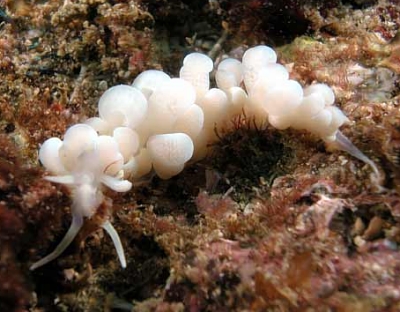

Concerning message #20948:
Hi Bill and everyone!
I would also like to contribute to the Forum photos of Phyllodesmium magnum juveniles and an egg laying photo close-up. The egg ribbon is not your average ribbon. The juveniles tend to be white and some have blue.
Locality: Old Woman Island, Mooloolaba, Sunshine Coast, 9-15 m, Queensland, Australia, Pacific Ocean, 17 October 2007, Subtidal. Length: 15-30 mm. Photographer: Gary Cobb.
Cheers
Gary Cobb
gary@nudibranch.com.au
Cobb, G.C., 2008 (Apr 3) Phyllodesmium magnum juveniles. [Message in] Sea Slug Forum. Australian Museum, Sydney. Available from http://www.seaslugforum.net/find/20978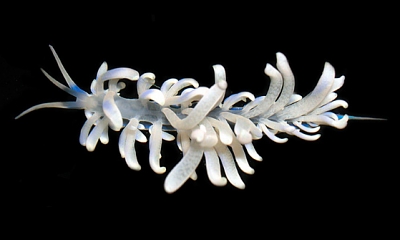
Thanks Gary,
These are very interesting observations. The egg ribbon is definitely unusual. I have seen a similar shaped ribbon before but my memory is not good enough to say whether it was a photo or a drawing or a 'live' specimen. It certainly would be good to know who else lays a ribbon like this.
Concerning the juveniles. I would be interested to know what makes you think they are juveniles of P. magnum and not another species. For example, have you seen a series of them of varying sizes? To identify species of this genus we use a variety of characters visible externally such as the position of the anus, the arrangement of the cerata, and colour pattern. The branching of the digestive gland in the cerata, and sometimes in the body wall is also important, as is the shape of the radular teeth. If these are juveniles of P. magnum - and from what I can see in your photos they could well - then I will need to be careful when I try to identify some of the non-descript whitish animals that are sent to the Forum.
Best wishes,
Bill Rudman
Re: Phyllodesmium magnum on Sinularia
April 3, 2008
From: Gary Cobb

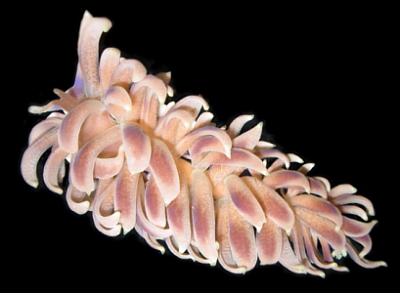
Concerning message #20948:
Hi Bill and everyone!
After reading David's message I thought you might like to see two more separate times were Phyllodesmium magnum is eating. In one photo there are two large animals really stuffing their faces. Photo on black is one of the animals that measured in at a whopping 124 mm long! In the other photo [lower] there are 4 animals fighting for the juicy soft coral meat.
Locality: Old Woman Island, Mooloolaba, Sunshine Coast, 14 m, Queensland, Australia, Pacific Ocean, 14 October 2007, Subtidal. Length: 25-124 mm. Photographer: Gary Cobb.
Cheers
Gary Cobb
gary@nudibranch.com.au
Cobb, G.C., 2008 (Apr 3) Re: Phyllodesmium magnum on Sinularia. [Message in] Sea Slug Forum. Australian Museum, Sydney. Available from http://www.seaslugforum.net/find/20977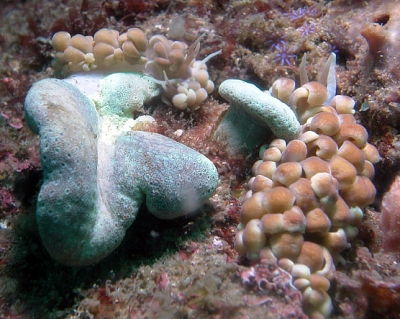
Thanks Gary,
As you know, I always appreciate photos of these animals 'doing things'.
Best wishes,
Bill Rudman
Phyllodesmium magnum on Sinularia soft coral
October 17, 2007
From: David Mullins


Dear Bill,
As I am now trawling through all my pics trying to create some sort of order I occasionally find something of interest.
Herewith are 3 pics of Phyllodesmium magnum that would seem to definitely depict it's food source. Gary Cobb and I found it upon this Sinularia soft coral at Old Woman Island and gently prised it off to check, as they really embed themselves making it difficult to observe the feeding process. Revealed beneath is the proof - an excavated crater.
The upper pic shows the specimen safely returned to habitat 2 weeks later still with most of its cerata.
Locality: Old Woman Island, Maroochydore, Sunshine Coast,, 14 metres, Queensland, Australia., Pacific Ocean., 02 October 2004, Soft coral on rocky reef. Length: 40 mm. Photographer: David Mullins.
I hope this is not "old news" for the forum.
Kind regards,
David Mullins.
david@nudibranch.com.au
Mullins, D.A., 2007 (Oct 17) Phyllodesmium magnum on Sinularia soft coral. [Message in] Sea Slug Forum. Australian Museum, Sydney. Available from http://www.seaslugforum.net/find/20948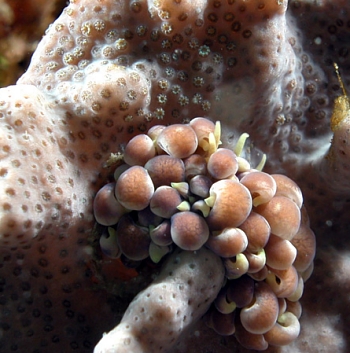
Dear David,
I did report it feeding on Sinularia some years ago but that doesn't make your observation 'old news'. We know so little about the biology of most nudibranchs that every little bit of information is valuable. Certainly one or two feeding records don't make a third or fourth redundant, as we need multiple sightings before we can form an opinion as to whether a first observation is a true indication of what that species eats or whether it is a mistake, or an anomaly, which can sometimes be the case.
I remember a few things from my school days and one was in chemistry experiments our teacher insisted that we had to repeat our tests until we got three results the same. To us, the last result was more important than the first because that was the one that confirmed our experiment - and let us go home.
There is no scientific rule saying just how many times an animal has to be observed eating the same food before we can say with any authority that that is what it eats, but at the moment I am more than happy to get more observations on any species - and the fifth or sixth observation is just as valuable as the first.
Best wishes,
Bill Rudman
Phyllodesmium magnum - trailing observation
September 5, 2006
From: Jean-François Hervé
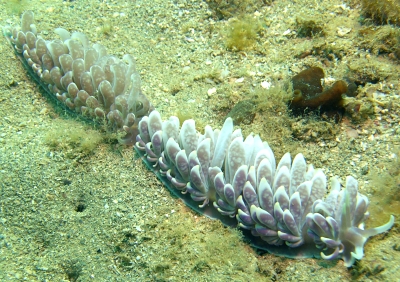
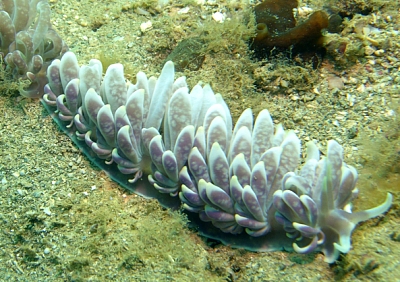
Here is another species I recently observed trailing. Trailing is a really curious behavior. Few animals are able to do that (like an elephant?!). Dave Behrens in his book (Nudibranch Behavior) explain the mucus role. Find a friend (same species) in the sea appears to me to be a difficult task and when you find one you must keep it.
Locality: Noumea, 7 m, New caledonia, Pacific Ocean, August 06. Length: 8+6 cm. Photographer: Jean-François Hervé.
Dr Rudman, do you know how they find partners?
Thank you.
Jean-François Hervé
jfherve@free.fr
Hervé, J.F., 2006 (Sep 5) Phyllodesmium magnum - trailing observation. [Message in] Sea Slug Forum. Australian Museum, Sydney. Available from http://www.seaslugforum.net/find/17721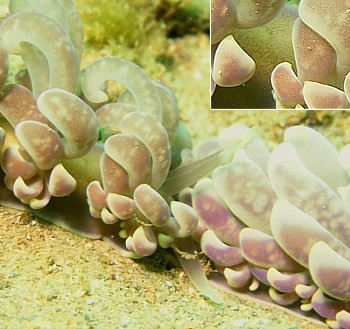
Dear Jean-François,
Thanks for this interesting observation. We are building quite a list of species on the Trailing page. This is the second record we have of this aeolid, Phyllodesmium magnum, trailing. At such a size it must be quite a spectacular sight. The other record is Binyamin Koretz's [message #14655] from the Red Sea.
As I have discussed elsewhere, we aren't really sure why this form of close trailing - head on tail - occurs. Those species of aglajids such as Navanax inermis, which feed on other opisthobranchs, certainly follow mucus trails in search of prey, and at times end up eating their own kind. Related species, such as Chelidonura varians, feed on flatworms, but also exhibit this trailing behaviour. I can understand that following mucus trails of your own species could be useful in finding a mate to breed with or even a source of food, but I can't see why some species have developed this extreme behaviour of not even losing touch with their 'friend'. Perhaps finding a mate is so difficult for these species that they can't afford to literally lose touch.
You ask how opisthobranchs normally find partners. Although many species use their chemosensory rhinophores to find their food, I know of no studies to show they can find partners by waterborne chemicals, except for the fairly recent discovery of a 'love drug' in Sea Hares which I mentioned a few days ago [message #17419] which seems to attract sea hares to others of their own kind who are egg-laying. It's possible that there are other waterborne signals for other opisthobranchs but at present it seems they meet either by chance, usually as an aggregation at a food item. We clearly have much to learn.
I am not sure if you kow that Phyllodesmium magnum is a solar-powered slug, obtaining much of it nutreint requirements from the microscopic plants [zooxanthellae] in its tissues. I have included a close-up inset in the photo alongside. The brown specks you can see in the skin are the zooxanthellae.
Best wishes,
Bill Rudman
Phyllodesmium magnum pair from the Red Sea
October 13, 2005
From: Binyamin Koretz
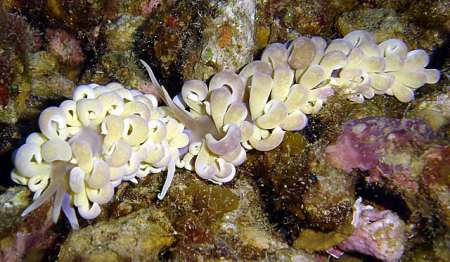

Dear Bill,
We found this Phyllodesmium magnum pair in the same spot where a week earlier we'd encountered a single individual. Perhaps he's the larger of the current pair but there's no way to be sure.
I thought this might be a prelude to mating, but we couldn't stay for more than a few minutes to watch (depth was 42 m).
Locality: Eilat, Divers' Village, Israel. Red Sea (Gulf of Eilat). Depth: 42 m. Length: 10 cm. 26 August 2005. mixed corals. Photo: Binyamin & Shulamit Koretz
Regards
Binyamin
binyamin@koretz.net
Koretz, B., 2005 (Oct 13) Phyllodesmium magnum pair from the Red Sea. [Message in] Sea Slug Forum. Australian Museum, Sydney. Available from http://www.seaslugforum.net/find/14655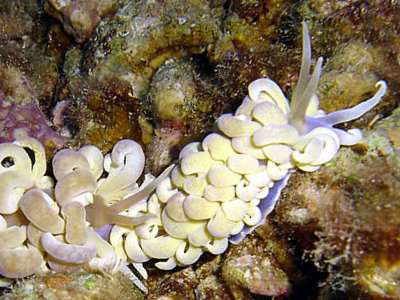
Dear Binyamin,
They are certainly spectacular looking aeolids. It's good to see the purplish body and foot with the white edge so clearly, as it was a feature very obvious in the animals I described from New Caledonia. I guess they stay in one spot if their food is nearby and plentiful. I agree that their 'closeness' suggests a prelude to mating, but I must say that is the norm amongst nudibranchs. I guess its an evolutionary imperative to mate whenever possible, when meeting a partner is in many ways a matter of luck.
Best wishes,
Bill Rudman
Phyllodesmium magnum from Elat, the Red Sea
April 13, 2005
From: Matan Ninio
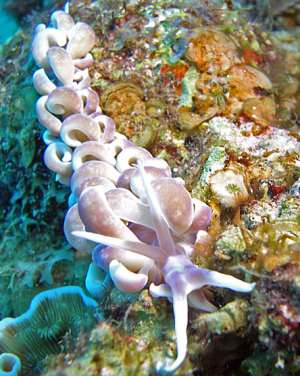
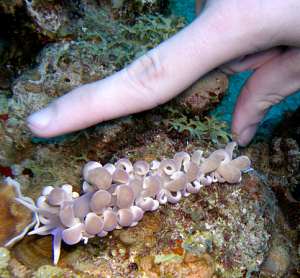
This lovely beast, Phyllodesmium magnum, was found last weekend in Eilat, during a day dive. It's not a common slug in our part of the world, and we have definetly never seen one this large.
It's the end of the algae season here, and the amazing collection of unusual slugs we had during the last month or so is thinning out. People are still reporting some unusual slugs (or 'Nivdibranchs', as we like to call them).
Locality: "The lighthouse" beach, Eilat. Israel, Red Sea. Depth: 15-20 m. Length: 10 cm. 18 March 2005. scattered corral heads on a sandy slope. Photographer: Razi (RubberDuck) Cohen.
Matan Ninio
matan@forumhasofiot.yam.dive.ninio.org
Ninio M., 2005 (Apr 13) Phyllodesmium magnum from Elat, the Red Sea. [Message in] Sea Slug Forum. Australian Museum, Sydney. Available from http://www.seaslugforum.net/find/13407
Dear Matan,
This is indeed a spectacular aeolid. It is nice to get a second record from the western side of the Indian Ocean.
Best wishes,
Bill Rudman
Re: Phyllodesmium magnum from Thailand
January 25, 2004
From: Paul Whitehead
Dear Bill,
Concerning your question. Yes, both animals were relocated from the rubble bottom, on to an adjacent plate coral for photographing.
Paul
whitehead@damnam.org
Whitehead, P., 2004 (Jan 25) Re: Phyllodesmium magnum from Thailand. [Message in] Sea Slug Forum. Australian Museum, Sydney. Available from http://www.seaslugforum.net/find/12012Thanks Paul,
It's useful to clarify these things so we don't end up making misleading assumptions on a species' food
Cheers
Bill Rudman
Re: Phyllodesmium magnum from Thailand
January 23, 2004
From: Paul Whitehead
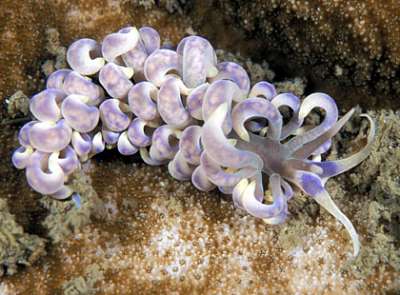
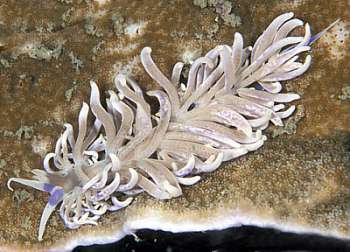
Dear Dr. Rudman,
I believe this may be a Phyllodesmium magnum(?)
A pair were seen, one being about 50 mm in length and the other 80-100 mm at a depth of 18 meters at Hin Plueng, an underwater mount close to Rayong and Sattaheap in Thailand. The mount is in an area in which the bottom is mixed sand and silt and you can see silt in the photographs. This is first time I have encountered such a nudibranch in this area, where I dive regulary. I also noted from reading your other posts that this may not be a common occurrence in the Thai Gulf area.
Paul Whitehead
whitehead@damnam.org
Whitehead, P., 2004 (Jan 23) Re: Phyllodesmium magnum from Thailand. [Message in] Sea Slug Forum. Australian Museum, Sydney. Available from http://www.seaslugforum.net/find/11983
Thanks Paul,
Yes this certainly looks like Phyllodesmium magnum. In your photos it seems to be on a hard coral. Was it putj tere for the photo? Why I ask is that this species is only known to feed on soft-corals, in particular species of the the genus Sinularia. It is possible it may eat other soft corals but I would be surprised if it also ate hard corals.
I can't really say whether it is uncommon in Thailand or not as we know so little about the species. I suspect it is not uncommon, but I guess it will take a few years of observations for us toe get a real idea of its distribution and abundance
Best wishes
Bill Rudman
Phyllodesmium magnum on Sinularia
January 17, 2003
From: Cameron Bee
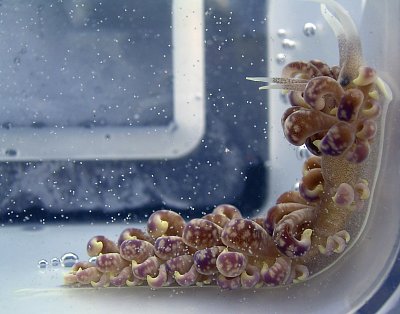
Dear Bill,
Could you give me some information on this nudibranch. I propagate corals for the aquarium trade and this slug has caused major damage to a colony of the soft coral Sinularia which we obtained from about 20km of Cairns [North Queensland, Australia].
It "ate" a substantial amount of the parent material that we use for our coral propagating. Typically it left an eaten trail up the side of the Sinularia and up to the branches but mostly on the side. Also where it had been feeding turned into nasty black necrotic tissue and basically caused the coral to start disintegrating. There were actually two of them in the tank always near each other. Apart from black rotting Sinularia, I noticed two egg masses which were white and had typical zig-zag pattern. When these egg masses were removed they began to release larvae which "swam" around like zooplankton and were attracted to the light.
When the adult nudibranch (assuming that these were their eggs) were disturbed, the lobes on its dorsal side detached and were very sticky and had to be pulled off. These sticky bits would then wriggle about like a lizard tail for about 3 hours which was until I left our factory, the following morning they were not moving and neither were the adults as oxygen in water had plummeted during the night.
Cameron
fishboy@smartchat.net.au


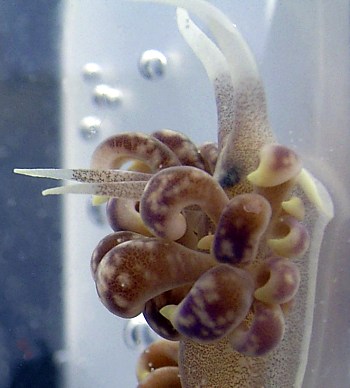
Dear Bee,
This is an aeolid nudibranch, Phyllodesmium magnum. Sorry it has caused so much damage, but Sinularia seems to be its preferred food, and your experience certainly supports that idea. The egg mass almost certainly belongs to Phyllodesmium and your description of it 'releasing' suggests that the larvae were about to hatch when you touched the egg mass. It may be worth keeping an eye out for any larval settlement. While the larvae of many nudibranchs spend a considerable time in the plankton feeding on phytoplankton, some species have an abbreviated non-feeding larval period, before settling on the adult food item to begin life as a crawling slugs. Non-feeding larvae can easily survive aquarium life, whereas feeding larvae need special facilities. Your animal could easily be one of the species with non-feeding larvae.
The sticky 'lobes' which you mention fall off and wiggle like lizard's tails, are called ceras, and as you'll see on the species Fact Sheet this is one of their defensive strategies. Dropping body parts like this is called autotomy.
One interesting feature of this species are the microscopic brown specks which can be seen in the close-up of the head alongside, and in the other photos. These brown specks are clusters of microscopic plants, called zooxanthellae, which it gets from the soft-corals it feeds on. It farms these plants, allowing them to photosynthesise in sunlight to provide it with nutrients. Have a look at the solar powered sea slug page for further information.
I am sure I am more sympathetic to Phyllodesmium than you are, but this is a very fascinating animal.
Cheers,
Bill Rudman
Phyllodesmium magnum from the Marshall Islands
September 11, 2002
From: Scott Johnson

Hi Bill,
Attached is a shot of Phyllodesmium magnum from the Marshall Islands. This specimen was under a dead coral rock at a depth of about 8 meters on an Utirik Atoll lagoon pinnacle. It may have been the only one I've seen here, although I am sending separately two photos of a similarly colored specimen but with uninflated cerata.
Scott Johnson
johnson@kmr.ll.mit.edu
Johnson, S., 2002 (Sep 11) Phyllodesmium magnum from the Marshall Islands. [Message in] Sea Slug Forum. Australian Museum, Sydney. Available from http://www.seaslugforum.net/find/7843Thanks Scott,
Bill Rudman
Unknown reef tank inhabitant
July 23, 2002
From: Dean Burchell
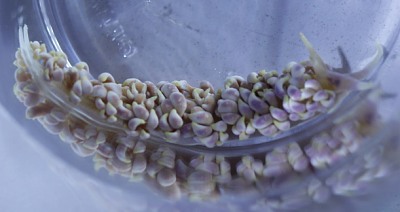
Hello,
I hope this forum doesn't mind a reef hobbyist who is curious about an ID. It appeared in my 65 gallon tank's overflow and I never saw it in my main tank. Just under two inches. Beige in color with purple and yellow highlights. Perhaps a Phyllodesmium magnum ?
Dean Burchell
Boston, MA, USA
dean@deanburchell.com
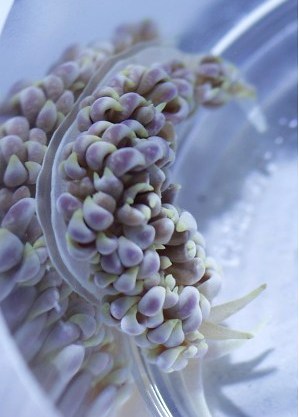
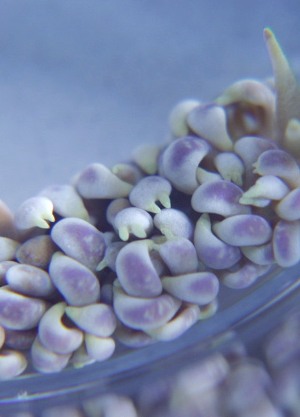
Dear Dean,
Yes your animal does look like Phyllodesmium magnum, which suggests it arrived in your tank on the soft coral that it feeds on. You don't give any indication of size - but clearly it has grown in your tank so you must have, or had, a healthy soft coral colony. There is another message on the Forum suggesting that P. magnum has done this before. I can't give you any tips on keeping it in an aquaria but if its food is there it should survive. I have included a closeup of one of your photos as it shows some of the cerata with abnormal double tips.
Best wishes,
Bill Rudman
Reef Tank Hitchhiker
May 21, 2002
From: Mike Nolette
I am writing you today because I seem to have found something in my reef aquarium that worries me. What I have found looks like the picture of Phyllodesmium hyalinum [or possibly (Phyllodesmium magnum]. I am uncertain which it was. When I tried to net the Nudibranch the pieces fell off just like it mentioned in the article on "the tail of a lizard". There were two of them on the Funger Coral and they looked very healthy, around 3 inches long and had a lot of long pieces hanging off of them. First of all I am wondering how much damage these could do to my Reef Tank, if there are ways to get rid of them if they are going to cause problems and lastly will they just stay on the one coral or are they prone to attacking other corals as well. I have had the tank set up for about 3 years but that one coral has only been in there for about 2-3 months. If you need anymore information just let me know. Thanks for all your help with this in advance.
Mike
mmotorcycle69@aol.com
Nolette, M., 2002 (May 21) Reef Tank Hitchhiker. [Message in] Sea Slug Forum. Australian Museum, Sydney. Available from http://www.seaslugforum.net/find/7012Dear Mike,
From your description it seems you do have a couple of Phyllodesmium. Without a photo of the slugs or the "Funger Coral' I'm afraid I can't identify the species with any certainty. Species of Phyllodesmium feed on soft corals and their close relatives, and it seems that most tropical species feed on only one species, or at most a few closely related species. For example, Phyllodesmium hyalinum feeds on species of Xenia and it seems that Phyllodesmium magnum feeds on species of Sinularia.
I guess identifying the species isn't that important to you. You are more concerned with what it will do to your tank's well-being. I suspect, as you do, that the animals arrived on your new soft coral which I can fairly confidently assume is their preferred food. If they are 3 inches long now, I guess they were much smaller when you put the new soft-coral in your tank or you would have seen them then. So it seems they have grown quite happily, without causing any outward signs of discomfort to your tank.
Should you keep them? I am of course biased in favour of the nudibranchs. I am not sure how long they will live but the worst they can do is eat all of your new coral. Unless you have other examples of the same species in your aquarium, I don't think they will move on to other things. When they reach maturity they most likely will mate and lay eggs but it is unlikely that the larvae produced will survive. If by chance some do, then the worst that can happen is that they will settle on the same soft coral and hasten its departure. My feeling is that here is a great opportunity for you to have a nudibranch in your tank - as long as you don't mind buying a new soft-coral [of the same species] every now and then.
best wishes,
Bill Rudman
Phyllodesmium magnum - size?
April 10, 2002
From: Valda Fraser
Dear Bill
This has been worrying me, so I thought I might as well clear it up with you. Your images of Phyllodesmium magnum are huge i.e. 110 and 130 mm - definitely living up to the name you gave them. The problem is that the ones that live here [see earlier message] are less than half that size. Is it common for a particular species to vary so radically in size from locality to locality?
Valda Fraser
valdafraser@mweb.co.za
Fraser, V., 2002 (Apr 10) Phyllodesmium magnum - size?. [Message in] Sea Slug Forum. Australian Museum, Sydney. Available from http://www.seaslugforum.net/find/4493Dear Valda,
No it certainly is not that common. Although it is possible that they don't grow as large in South Africa, or large ones are usually eaten, or you haven't seen a large one yet, the other possibility is that your animal is not P. magnum. I would need to have a look at its anatomy to be sure. Perhaps you were right in thinking it was P. hyalinum. It would be interesting to know what it feeds on.
Best wishes,
Bill Rudman
Food of orange Phyllodesmium magnum
September 11, 2001
From: Leslie Chan
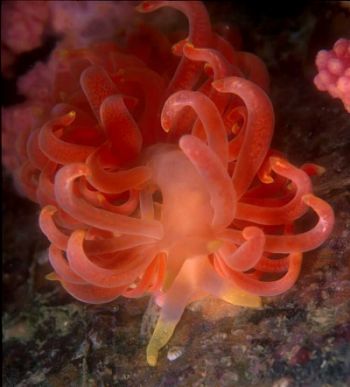
Dear Bill
I found one photo showing some orange soft coral behind the orange Phyllodesmium magnum. It seems that is the nudibranch's food source.
Best regards
Leslie
leslie@marinelife.com.hk
Chan, L., 2001 (Sep 11) Food of orange Phyllodesmium magnum. [Message in] Sea Slug Forum. Australian Museum, Sydney. Available from http://www.seaslugforum.net/find/5249Thanks Leslie,
It's an interesting find.
Bill Rudman
An orange Phyllodesmium magnum from Hong Kong
September 9, 2001
From: Leslie Chan

Dear Dr. Rudman
Recently I found another colour of Phyllodesmium magnum in Hong Kong. Please confirm that I have correctly identified it.
South Ninepin Group, 12m. 2 August, 2001. The animal was about 6 cm long.
Best regards
Leslie
leslie@marinelife.com.hk
Chan, L., 2001 (Sep 9) An orange Phyllodesmium magnum from Hong Kong. [Message in] Sea Slug Forum. Australian Museum, Sydney. Available from http://www.seaslugforum.net/find/5236Dear Leslie,
I have never seen a P. magnum this colour before but I am sure that is what it is. The purplish tinge to the skin, the yellow tipped rhinophores, oral tentacles and cerata, and yellow border tothe foot are all characteristic of that species. The only difference seems to be that it has been eating something orange, because the orange seems confined to the digestive gland in the cerata. Did you by chance find it on, or near a red or orange soft coral or gorgonian?
Best wishes,
Bill Rudman
Phyllodesmium magnum from Queensland
July 10, 2001
From: Nigel Holmes


Greetings Bill
A colleague at the Environmental Protection Agency in Gladstone, Jim Cruise, suggested I send you the attached photo for your interest. Jim suggested that it was unusual and identified it as a species of Phyllodesmium. It was well camouflaged on the soft coral featured. The location was the Keppel Islands, off Rockhampton, Queensland, Australia.
Details: Approx 35mm long, found at Humpy Island, Keppel Islands in 9m of water. 26 December 2000.
Regards
Nigel Holmes
Manager
(EPA) Rockhampton
holmesnjc@optusnet.com.au
Holmes, N., 2001 (Jul 10) Phyllodesmium magnum from Queensland. [Message in] Sea Slug Forum. Australian Museum, Sydney. Available from http://www.seaslugforum.net/find/4795Dear Nigel,
Thanks for the interesting photo. It's Phyllodesmium magnum. There aren't too many records of it from anywhere, so every new one counts. As far as I know it has not been reported from eastern Australia but it has been found in nearby New Caledonia. I think the soft coral is probably Sinularia which I reported it feeding on in Western Australia. This is a nice confirmation of its food.
Best wishes,
Bill Rudman
Phyllodesmium magnum from South Africa
May 26, 2001
From: Valda Fraser

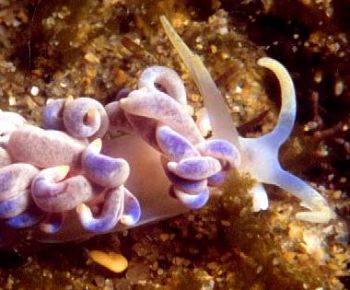
Dear Bill
This nudibranch was white when I saw it and I felt sure I'd captured a nice, clear picture of Phyllodesmium hyalinum. I was shocked to find a purple creature in my slide. Is it what I thought?
Words of wisdom, please.
Locality: Hibberdene, south coast KwaZulu-Natal, SOUTH AFRICA, 20m
Date: May, 2001
Size: 15mm
Regards
Valda Fraser
valdafraser@mweb.co.za
Fraser, V., 2001 (May 26) Phyllodesmium magnum from South Africa. [Message in] Sea Slug Forum. Australian Museum, Sydney. Available from http://www.seaslugforum.net/find/4424Dear Valda,
With the proviso that I know nothing about its anatomy, I think your animal is Phyllodesmium magnum. If so, it is a rather large extension to its known geographic distribution. At present it is only known from the western Pacific and Western Australia.
Cheers,
Bill Rudman
Phyllodesmium magnum from Hong Kong
March 4, 2001
From: Bernard Picton
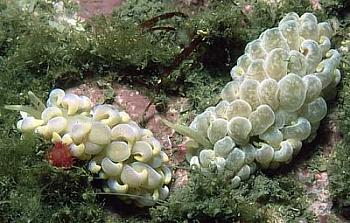
Hi Bill,
Here is a photograph of two Phyllodesmium magnum from Breaker's Reef, Hong
Kong, as described in your paper in 1991. They are the two with your Australian Museum Number AM C139042 collected 19 April 1983.
Bernard
bernard.picton.um@nics.gov.uk


Thanks Bernard,
As well as using the whole photo I've also displayed the two animals at a higher magnification.
Bill Rudman
Phyllodesmium magnum from Japan
November 23, 1999
From: Yasuhiro Shirai

Dear Bill,
Thank you for quick reply.
Today, I attached some pictures. I think they are of Phyllodesmium magnum.
What do you think? I would appreciate your comments.
PHOTO 36: I saw it at Kushimoto, Japan.
It was on a rocky reef, depth -13m, water temperature 23.8C, 130mm length, July 1999.
PHOTO36-1 is zoom picture of its head.
PHOTO 81: From same diving point, on rocky reef, depth -10m, water temperature 23.0C, 100mm length, November 1999. PHOTO 81-1 is zoom picture of its head.
Best regards.
Yasuhiro Shirai.
http://www.e-net.or.jp/user/yasuhiro/
yasuhiro@e-net.or.jp
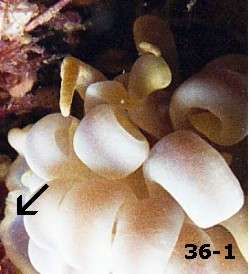
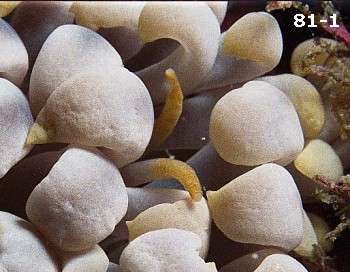
Dear Yasuhiro,
Yes your animals are Phyllodesmium magnum which appears to be widely spread in the Western Pacific. Although no physiological studies have been undertaken on this species, the large flattened cerata, the greatly branched digestive gland, and the concentration of zooxanthellae in cells near the dorsal surface of the animal suggest that this species is also "solar powered".
Your photo 36-1 clearly shows the yellowish edge to the foot, and at the bottom of photo 81 I am pretty sure that the soft coral you can see is Sinularia which is the soft coral I reported it being associated with in Western Australia (Rudman, 1991).
Best wishes,
Bill Rudman.
